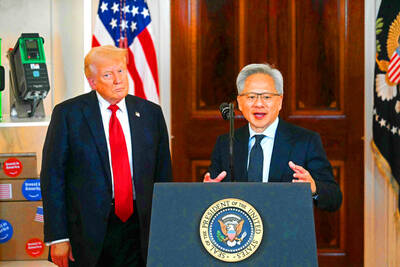Japan’s trade deficit last month nearly doubled from a year ago, official data showed yesterday, as soaring energy bills eclipsed an improving export picture.
Government figures showed that Japan logged a bigger-than-expected ¥1.09 trillion (US$10.9 billion) trade deficit last month.
The latest figure, a record for October, was nearly double a ¥556.2 billion shortfall a year earlier and marked the 16th straight month of deficit, the longest stretch in over three decades.
Energy imports surged after the 2011 Fukushima Dai-ichi crisis forced the shutdown of Japan’s nuclear reactors, which once supplied a third of the nation’s power.
A sharp decline in the yen, which is good for exporters’ profitability, has also forced up the cost of importing pricey fossil-fuels to plug the country’s energy gap.
Japan’s trade imbalance was largely due to the rising cost — and volume — of crude oil and liquefied natural gas shipments as well as surging purchases of electronic parts.
Overall, imports jumped 26.1 percent to ¥7.2 trillion from a year ago, rising at their fastest pace in over three years.
Exports were also up again, rising 18.6 percent to ¥6.1 trillion, according to the government.
“Exports were rather weak until September, but now they seem to be recovering,” Mizuho Research Institute senior economist Yasuo Yamamoto said. “But imports have increased substantially, contributing to the trade deficit.”
Yesterday’s trade data came after separate figures last week showed Japan’s GDP growth halved in the July-September quarter, on slower exports and consumer spending.
“After we saw exports decrease in the July-September GDP, these October export figures are somewhat of a relief,” Yamamoto told Dow Jones Newswires.
“I think we’ll be seeing the trade deficit gradually shrinking, but only incrementally, since the weaker yen is pushing up import prices,” he added.
The Bank of Japan was to start a two-day policy meeting yesterday with markets keen to see if its expands its massive stimulus drive.

Taiwan Semiconductor Manufacturing Co (TSMC, 台積電) last week recorded an increase in the number of shareholders to the highest in almost eight months, despite its share price falling 3.38 percent from the previous week, Taiwan Stock Exchange data released on Saturday showed. As of Friday, TSMC had 1.88 million shareholders, the most since the week of April 25 and an increase of 31,870 from the previous week, the data showed. The number of shareholders jumped despite a drop of NT$50 (US$1.59), or 3.38 percent, in TSMC’s share price from a week earlier to NT$1,430, as investors took profits from their earlier gains

AI TALENT: No financial details were released about the deal, in which top Groq executives, including its CEO, would join Nvidia to help advance the technology Nvidia Corp has agreed to a licensing deal with artificial intelligence (AI) start-up Groq, furthering its investments in companies connected to the AI boom and gaining the right to add a new type of technology to its products. The world’s largest publicly traded company has paid for the right to use Groq’s technology and is to integrate its chip design into future products. Some of the start-up’s executives are leaving to join Nvidia to help with that effort, the companies said. Groq would continue as an independent company with a new chief executive, it said on Wednesday in a post on its Web

CHINA RIVAL: The chips are positioned to compete with Nvidia’s Hopper and Blackwell products and would enable clusters connecting more than 100,000 chips Moore Threads Technology Co (摩爾線程) introduced a new generation of chips aimed at reducing artificial intelligence (AI) developers’ dependence on Nvidia Corp’s hardware, just weeks after pulling off one of the most successful Chinese initial public offerings (IPOs) in years. “These products will significantly enhance world-class computing speed and capabilities that all developers aspire to,” Moore Threads CEO Zhang Jianzhong (張建中), a former Nvidia executive, said on Saturday at a company event in Beijing. “We hope they can meet the needs of more developers in China so that you no longer need to wait for advanced foreign products.” Chinese chipmakers are in

POLICY REVERSAL: The decision to allow sales of Nvidia’s H200 chips to China came after years of tightening controls and has drawn objections among some Republicans US House Republicans are calling for arms-sale-style congressional oversight of artificial intelligence (AI) chip exports as US President Donald Trump’s administration moves to approve licenses for Nvidia Corp to ship its H200 processor to China. US Representative Brian Mast, the Republican chairman of the US House Committee on Foreign Affairs, which oversees export controls, on Friday introduced a bill dubbed the AI Overwatch Act that would require the US Congress to be notified of AI chips sales to adversaries. Any processors equal to or higher in capabilities than Nvidia’s H20 would be subject to oversight, the draft bill says. Lawmakers would have